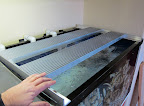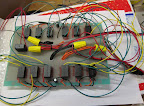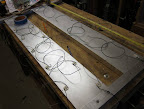A bit of a setback on the light fixtures. 
Went to order the rest of the heat sinks I needed, and they were out.
I was basing a lot of the design on these surplus heats sinks, which for a while, the store had a ton of.
So, back to the drawing board a bit on the actual construction. (LED plan remains the same)
I will now be ordering four 5.9" x 40" big heat sinks, and gluing them to that.
No real difference overall, other than it increases the cost.
Might even make the build a bit simpler.
Here is the LED/heatsink layout. Left side will be a mirror image.
Attached files /attachments/sites/default/files/mainlightsdwg.jpg
Went to order the rest of the heat sinks I needed, and they were out.
I was basing a lot of the design on these surplus heats sinks, which for a while, the store had a ton of.
So, back to the drawing board a bit on the actual construction. (LED plan remains the same)
I will now be ordering four 5.9" x 40" big heat sinks, and gluing them to that.
No real difference overall, other than it increases the cost.
Might even make the build a bit simpler.
Here is the LED/heatsink layout. Left side will be a mirror image.
Attached files /attachments/sites/default/files/mainlightsdwg.jpg




